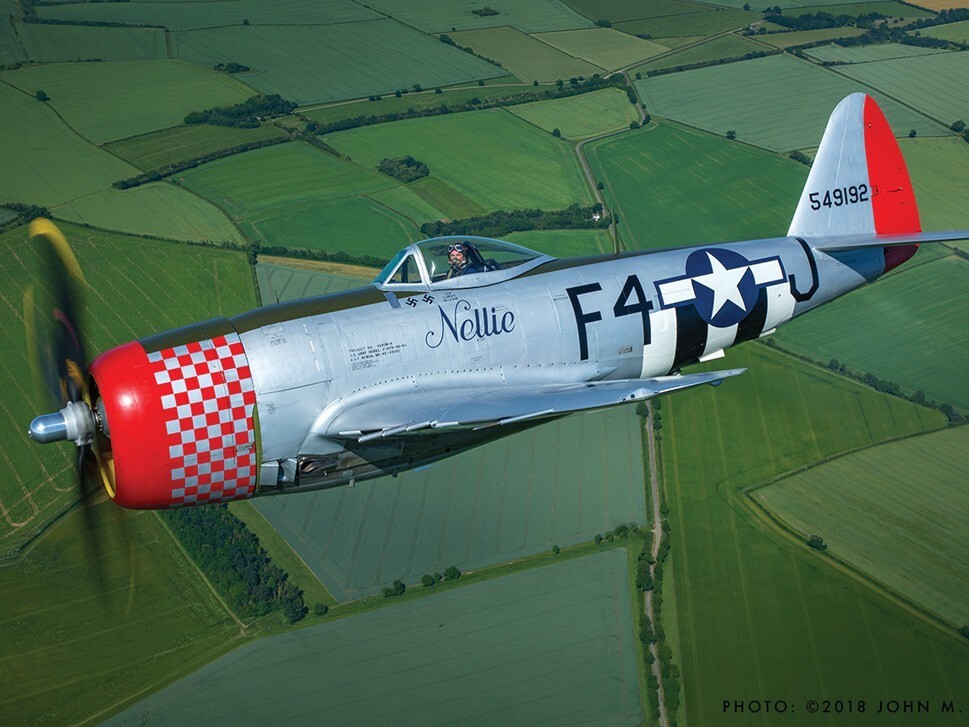- 10 May 2022
- AvBuyer
- GA Buyer Europe
When a Thunderbolt Strikes: The History of the P-47
Love vintage airplanes? Then you'll undoubtedly love the mighty P-47 Thunderbolt. Learn all about this historic airplane with expert Jamie Chalkley, here...
Back to Articles
You might think from the title this is going to be a lesson in meteorology! But, instead, it’s about another phenomenon that strikes from the heavens: the mighty P-47 ‘Thunderbolt’!
Many of you will know the Thunderbolt by its slightly less punchy nickname; the ‘Jug’! The reason behind this rather unusual aviation name seems to cause a bit of a divide. It’s either; ‘Jug’ short for ‘Juggernaut’, due to its brute size, weight and almost unstoppable power once it gets tanking along, or ‘Jug’ due to its blunt-shape fuselage resembling a 1940s milk jug!
Bear in mind that at the time it was presented to the world, the P-47 was the largest single-engine fighter to take to the sky. Pilots were sceptical about its size and weight so they may have unfairly gone with the latter ‘Jug’… But, in a relatively short period of time, it became a highly appreciated combat aircraft. So out of respect I rather hopefully lean towards the former ’Jug’. But no one seems to know for sure!
The Thunderbolt was designed by lead engineer Alexander Kartveli and following completion of its test flight programme it was produced in the thousands by US manufacturer Republic Aviation. Between 1941 to 1945, more than 15,500 P-47s were built! And any early scepticism was soon long-forgotten because, in contrast to those early concerns, it proved one of the most effective single-engine combat aircraft of WWII.
Here's why…
Thanks to its mighty 2,000 hp Pratt & Whitney R-2800 Double Wasp radial engine, bearing it’s teeth and growling through its 18 cylinders (two rows of nine!), not to mention backed up by its whopping turbocharger, it ensured a smooth delivery of awesome power from sea level right up to 40,000 ft. And put the aircraft nose down in a dive attack, it topped out at over 400 mph (a later experimental model achieved 505 mph! — apparently a record that wasn’t ‘officially’ broken in a piston-powered aircraft until 1989).
However, there was one issue with that huge engine up front: it needed a huge prop to deliver the thrust. It was no less than 12 ft 2 inches in diameter! It was so big the designers really had to knuckle down and work out how to keep it off the ground during taxi, take-off and landing. Their solution: a 9-inch telescopic extension to the landing gear legs when in the down position, and which helpfully retracted back in when the gear was raised — otherwise the legs simply wouldn’t fit inside the undercarriage bay.
During late 1942, the P-47 headed for the UK. Some 800 were delivered to the British and Commonwealth forces. Again, there was some hesitancy to accept this mammoth aircraft was going to be up for the job, but it did the airmen proud as it escorted numerous B-17s on missions to Germany and fended off the formidable Fw190. Not to mention it took out a high number of BF110s.
In 1944 a limited number of ‘M’ models found their way to the UK as V1 Rocket interceptors. With a top speed of 473 mph the aircraft proved once more to be the underdog that outperformed so many other types.
Heavyweight Fighter
I keep mentioning size and weight, but just how big was the ‘Jug’? With an empty weight of 10,000 lbs and a fully loaded combat weight of 17,500 lbs (that’s eight tons by the way!), it was definitely the heaviest fighter in town. It was almost 50 percent heavier than a P-51 Mustang (and four feet longer and three feet wider) and more than twice the weight of a Spitfire.
It was just huge parked alongside other fighters. But many pilots really grew to love it. Not just for its amazing performance; not just for its amazing brute strength (with an ability to take a lot of combat punishment), but it also had a much roomier cockpit (which many described as having a ‘lounge chair’ to fly from) and excellent visibility from the teardrop canopy (an improvement from the early ‘razorback’ canopies). All in all, it quickly became a surprising favourite of those that flew it.
Legacy
From its first flight on the 6th May 1941, through to its post WWII retirement in the late 1960s (the last being the Peruvian Air Force), the P-47 (or ‘Jug’ to its friends) was an outstanding aircraft. It didn’t quite have the range of the P-51 Mustang (approximately 50 percent in fact) but its sheer rugged personality and its many combat attributes made it a much-loved type. Perhaps it’s fair to say that it’s an aircraft that, outside of those that flew them, doesn’t get the full credibility it deserves.
The P-47 undertook some 500,000 missions during WWII. It shot down over 7,000 enemy planes. And of those, it shot down more Luftwaffe aircraft (3,572 recorded) than any other Allied fighter. America’s top Ace of WWII, Major Gabby Gabreski, shot down 28 aircraft from his time in the P-47. It also served in every theatre of WWII and has been operated by over 20 nations in a military role.
Thunderbolt the Sequel!
In 1965, a company by the name of ‘Fairchild Hiller’ (following their purchase of the Hiller Helicopter company a year earlier) acquired the Republic Aviation Company. They became known as Fairchild Industries. In 1971, a subsidiary called ‘Fairchild Republic Division’ began developing the A-10, a twin turbofan, subsonic, heavyweight attack aircraft. The design team gave a firm nod to their former glory days of the P-47 and called it the ‘Thunderbolt II’.
The P-47 remains today one of the greats of WWII. It didn’t quite get the stage presence of the Spitfire or P-51, but it was without a doubt an aircraft that made a significant difference to the air combat results of WWII. It was a real workhorse, it got on with the job in hand, and it kept many of its great pilots safe and brought them back home time and time again. It might be nicknamed the ‘Jug’ but in combat it could definitely strike like a thunderbolt!
‘Nellie’
The picture aircraft was built in 1945 at Republic’s factory in Indiana, USA. Its specific USAAF history is unknown, but what we do know is this: Following a stint in the Air Training Command at the end of the war, like many others, the aircraft went into storage. But you can’t keep a good aircraft down, and this sky searching P-47 found air under its wings once more in September 1952 when it went back into operational service. A year later (and along with several other P-47s) it was back on duty, this time with the Peruvian Air Force, and there it stayed there until retirement in early 1967. It served them well as both an active front-line combat aircraft and as an advanced fighter-trainer.
Following another short spell of storage, the yet-to-be-named ‘Nellie’ was airborne again in 1971 and changed hands a few more times before ending up with world-renowned warbird specialist Steve Hinton in Chino, California. His specialist team replaced the engine and carried out a restoration to the airframe inside and out, and the P-47 flew like a new aircraft again in August 1985.
A UK visit came next; the year was 1986 and the aircraft was presented to UK fans, flying under its nose-art name of ‘No Guts, No Glory’ and operated by first-class warbird company ‘The Fighter Collection’ through to 2007, when the aircraft went stateside once again. But it obviously missed flying in the UK's fair-weather skies and over the UK's wonderful countryside because in 2018 ‘Nellie’ was back — and hasn’t left since.
If you want to see ‘Nellie’ flying then you won’t get a better demonstration than seeing the Ultimate Fighters Display Team where ‘Nellie’ leads the formation — superb!!
Related Articles
- 04 Mar 2022
- AvBuyer
- GA Buyer Europe
- 28 Jan 2022
- AvBuyer
- GA Buyer Europe
SHARE THIS ARTICLE
Other Articles
Featured Aircraft
Price entered as: £70,000 No VAT, Price Reduced
United Kingdom - England


